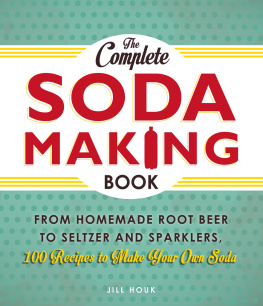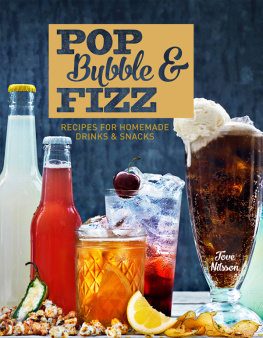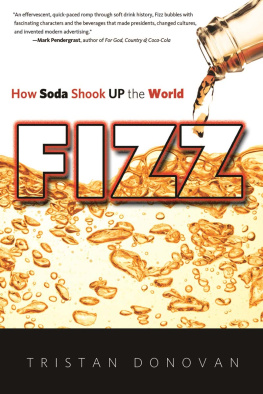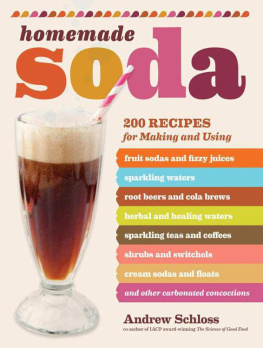The Complete Soda Making Book
FROM HOMEMADE ROOT BEER
TO SELTZER AND SPARKLERS,
100 Recipes to Make Your Own Soda
JILL HOUK

AVON, MASSACHUSETTS
To my son, Sam, who is my reason for making homemade sodas that are healthier and more eco-friendly than whats available in stores.
INTRODUCTION
Even a few years ago, the thought of making your own club soda and carbonated drinks at home seemed daunting. However, with recent popularity of at-home carbonators (from manufacturers such as SodaStream, Cuisinart, and iSi), times have changed, and many home gourmets are not only making sparkling water at home; they are also experimenting with their own versions of colas, fruit sodas, and unusual sodas, such as herbal drinks.
And with good reason! Not only can you save money by making your own sparkling beverages at home; you can also control exactly what goes into your drinks, and lessen your environmental impact. And, most importantly, you can pick up a fun new hobby! In addition, home soda-making goes hand-in-hand with home mixology. If youre investing in making craft cocktails at home, take it a step further by creating your own carbonated mixers.
Once you master a few simple principles, making sparkling beverages at home is quick and easy. Using this book as a guide, youll be an expert in no time. First, begin by reading , youll find everything from replicas of store-bought colas, root beers, and ginger ales, to fruit sodas, to unusual combinations such as pineapple cilantro soda or soda with lavender.
In , youll use the sodas you know how to make to create other drinks and even foods! Youll find nonalcoholic options, such as a Shirley Temple or a spooky bubbling punch (perfect for Halloween!), and delicious cocktails, like the Old-Fashioned, the Dark and Stormy, and the unique Sparkling Cosmopolitan. And, finally, if youre getting hungry, the last section contains recipes for foodslike Cola-Brined Fried Chicken or Strawberry Soda Pop Cakewhich also rely on homemade soda pop as an ingredient.
So what are you waiting for? These bubbles arent going to hang around forever. Lets get reading and cooking!
Part 1
AN OVERVIEW OF CARBONATION
Everyone can name their favorite fizzy beverage. Whether its plain sparkling water, store-bought root beer, or a homemade peach soda, we all have a sparkling drink that we call our own. Few of us, however, can explain why certain drinks are fizzy, or explain the magic of carbonation. Luckily, carbonation is a simple concept with an interesting history. The following chapters explain what carbonation is, and tell you how it went from a natural phenomenon to an everyday, at-home process.
CHAPTER 1
Carbonating 101
In this chapter, youll learn about the background of carbonationwhat it is, its history, and why youd want to carbonate water at home.
What Is Carbonation?
Carbonation is the suspension of a gas called carbon dioxide in a liquid. Its the bubbly part of club soda, soda pop, champagne, or beer. A form of carbonation also occurs in bread (its what helps bread rise) and cheese (such as Swiss cheese, in which carbonation is responsible for the holes). Carbon dioxide stays dissolved in water under pressure, and when pressure is released, it separates into small gas bubbles. Tightly closed bottles of carbonated beverages appear not to have bubbles in them because theyre under pressure. As soon as you open them, you reduce the pressure, releasing the carbon dioxide from the liquid and creating the bubbles we all know and love.
CARBONATION IN NATURE
The first examples of carbonation occurred naturally. Some mineral springs naturally have carbon dioxide dissolved in water, resulting in effervescent waters. Examples of natural springs are Les Bouillens Springs in France (the source of Perrier sparkling water), as well as Poland Spring and Garden Spring in the town of Poland, Maine (the source of Poland Spring bottled water). These springs were formed when carbon dioxide gas became trapped within the springs rocks during formation. As water encountered the carbon dioxide, it became bubbly. Waters from these springs were (and are still!) bottled and sold as health tonics.
CARBONATION WITH YEAST
Another type of natural carbonation occurs with yeasta microscopic, one-celled fungus. Yeast naturally exists in the air, in soil, in water, and on most surfaces. Yeast feeds on simple sugars, which are abundantly found in fruit. Thousands of years ago, yeast landed in fruit juice, consumed the sugars in the juice, and left behind byproducts of alcohol and carbon dioxide. Some early carbonated beverages resulted when juice and yeast were placed together into airtight containers. Initially, this process was a happy accident, but once the process was discovered, it was refined by the Romans, and people have been able to create carbonation themselves by adding yeast to juice. The yeast consumed the sugar in the juice, and created alcohol and carbon dioxide. Because they were together in a closed container, the carbon dioxide dissolved in the juice, creating carbonation. The carbonation was detected once the containers were opened and bubbles appeared.
EARLY COMMERCIAL CARBONATION
In the eighteenth century, Joseph Priestley, a British chemist and theologian, learned how to make carbonated water by infusing water with the air found in breweries above fermentation tanks. At roughly the same time, a Swedish chemist and mineralogist, Torbern Bergman, discovered how to carbonate water using similar methods. Later in that same century, German-born Swiss watchmaker J.J. Schweppe created a commercial process for carbonation based on Priestleys and Bergmans methods.
EARLY AT-HOME CARBONATION
Carbonation became possible at home in the mid-nineteenth century with the introduction of siphons, canisters that hold water and allow it to be carbonated by a single-use small carbon dioxide charger. Shortly thereafter, in the early twentieth century, devices were created that allowed consumers to carbonate bottles of water using larger carbon dioxide carbonators. These carbonators could carbonate up to 30 liters of water per carbonator. At-home carbonators were typically used in bars, and in the homes of upper-class families, and were more common in Europe than in North America. Some of the current at-home carbonator brands, such as iSi and SodaStream, can trace their starts as far back as the early twentieth century.
Nowadays, at-home carbonators are readily available to consumers, with manufacturers selling a range of products to suit every consumers budget, need for portability, and decor.
Why Carbonate at Home?
Why should you make your own sparkling beverages when there are so many terrific bubbly waters and sodas available in local grocery stores? There are several reasons for going the do-it-yourself route. Not only is at-home carbonation and soda-making fun; it is easy on the pocketbook, affords the most flexibility for creating your favorite flavors, and is better for the planet.
ITS LESS EXPENSIVE
First, at-home carbonation can be economical. When you consider that the least expensive sparkling water you can buy in a store is roughly 75 cents per liter, you definitely save money by making your own sparkling water. Most municipalities sell water for less than one cent per gallon. Even when you consider the cost of the carbonation device (devices have a starting price of $80 and have enough supplies to make your initial 60 liters of sparkling water) and the cost of refilling CO2 chargers (typically around $15 for 60 liters of water), the cost of making sparkling water at home comes out to approximately 50 cents per liter (assuming you make at least 240 liters with your machine). Once you reach this initial amount of consumption (which can take anywhere from nine months to a year, if you have a liter of water per day), the cost of each liter of water is roughly 25 cents per liter.








